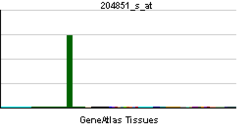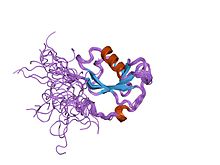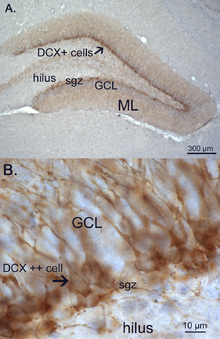- Doublecortin
-
Doublecortin 
PDB rendering based on 1mjd.Available structures PDB 1MJD, 2BQQ Identifiers Symbols DCX; DBCN; DC; FLJ51296; LISX; SCLH; XLIS External IDs OMIM: 300121 MGI: 1277171 HomoloGene: 7683 GeneCards: DCX Gene Gene Ontology Molecular function • microtubule binding Cellular component • cytoplasm
• cytosol
• cytoskeleton
• microtubule associated complexBiological process • multicellular organismal development
• nervous system development
• axon guidance
• central nervous system development
• cell differentiation
• intracellular signal transductionSources: Amigo / QuickGO RNA expression pattern 

More reference expression data Orthologs Species Human Mouse Entrez 1641 13193 Ensembl ENSG00000077279 ENSMUSG00000031285 UniProt O43602 Q3V349 RefSeq (mRNA) NM_000555.3 NM_010025 RefSeq (protein) NP_000546.2 NP_034155 Location (UCSC) Chr X:
110.54 – 110.66 MbChr X:
140.29 – 140.37 MbPubMed search [1] [2] Doublecortin 
solution structure of the n-terminal dcx domain of human doublecortin-like kinase Identifiers Symbol DCX Pfam PF03607 InterPro IPR003533 SCOP 1mfw Available protein structures: Pfam structures PDB RCSB PDB; PDBe PDBsum structure summary Doublecortex; lissencephaly, X-linked (doublecortin), also known as DCX, is a gene.[2]
Doublecortin (DCX) is a microtubule-associated protein expressed by neuronal precursor cells and immature neurons in embryonic and adult cortical structures. Neuronal precursor cells begin to express DCX while actively dividing, and their neuronal daughter cells continue to express DCX for 2–3 weeks as the cells mature into neurons. Downregulation of DCX begins after 2 weeks, and occurs at the same time that these cells begin to express, NeuN, a marker for mature neurons.[3]
Due to the nearly exclusive expression of DCX in developing neurons, this protein has been used increasingly as a marker for neurogenesis. Indeed, the levels of DCX expression increase in response to exercise,[4] which occurs in parallel with increased BrdU labelling, currently a "gold standard" in measuring neurogenesis.
Doublecortin was found to bind to the microtubule cytoskeleton. In vivo and in vitro assays show that Doublecortin stabilises microtubules and causes bundling.[5] Doublecortin is a basic protein with an iso-electric point of 10, typical of microtubule-binding proteins. However, its sequence contains no known microtubule-binding domain(s).
The detailed sequence analysis of Doublecortin and Doublecortin-like proteins allowed the identification of an evolutionarily conserved Doublecortin (DC) domain. This domain is found in the N terminus of proteins and consists of one or two tandemly repeated copies of an around 80 amino acids region. It has been suggested that the first DC domain of Doublecortin binds tubulin and enhances microtubule polymerisation.[6]
Contents
Interactions
Doublecortin has been shown to interact with PAFAH1B1.[7]
Relevance to Human disease
Doublecortin is mutated in humans in the syndrome X-linked Lissencephaly and double cortex, X-linked lissencephaly means that the disease produce a smooth brain because of lack of migration of immature neurons, without the normal folds of the brain surface. In the case of double cortex the disease is characterized by abnormal migration during development that results in two bands of misplaced neurons in the subcortical white matter that generate two cortex, giving the name to the syndrome,[8] clinically patients with X-linked lissencephaly, the majority of times are males with a mutation in the their X chromosome. In the case of double cortex the majority of the patients are females with a mutation in one of the X-chromosome, they presents intractable seizures and mental retardation. The severity of the disease can be implied by a gene dosage effect, meaning that in the case of males, with only one X chromosome, there is no protein, however in the case of females with two X chromosome, the mutation in one X chromosome can somehow be compensated, however not enough functional protein is produced in the double cortex patients. The mutation was discovered by Joseph Gleeson and Gene Hunter Christopher A. Walsh in Boston.[citation needed]
See also
References
- ^ Oomen, Charlotte A.; Girardi, Carlos E. N.; Cahyadi, Rudy; Verbeek, Eva C.; Krugers, Harm; Joëls, Marian; Lucassen, Paul J. (2009). Baune, Bernhard. ed. "Opposite Effects of Early Maternal Deprivation on Neurogenesis in Male versus Female Rats". PLoS ONE 4 (1): e3675. doi:10.1371/journal.pone.0003675. PMC 2629844. PMID 19180242. http://www.pubmedcentral.nih.gov/articlerender.fcgi?tool=pmcentrez&artid=2629844.
- ^ EntrezGene 1641
- ^ Brown, Jason P.; Couillard-Després, Sébastien; Cooper-Kuhn, Christiana M.; Winkler, Jürgen; Aigner, Ludwig; Kuhn, H. Georg (2003). "Transient expression of doublecortin during adult neurogenesis". The Journal of Comparative Neurology 467 (1): 1–10. doi:10.1002/cne.10874. PMID 14574675.
- ^ Couillard-Despres, Sebastien; Winner, Beate; Schaubeck, Susanne; Aigner, Robert; Vroemen, Maurice; Weidner, Norbert; Bogdahn, Ulrich; Winkler, JüRgen et al. (2005). "Doublecortin expression levels in adult brain reflect neurogenesis". European Journal of Neuroscience 21 (1): 1–14. doi:10.1111/j.1460-9568.2004.03813.x. PMID 15654838.
- ^ Horesh D, Sapir T, Francis F, Wolf SG, Caspi M, Elbaum M, Chelly J, Reiner O (September 1999). "Doublecortin, a stabilizer of microtubules". Hum. Mol. Genet. 8 (9): 1599–610. PMID 10441322.
- ^ Sapir T, Horesh D, Caspi M, Atlas R, Burgess HA, Wolf SG, Francis F, Chelly J, Elbaum M, Pietrokovski S, Reiner O (March 2000). "Doublecortin mutations cluster in evolutionarily conserved functional domains". Hum. Mol. Genet. 9 (5): 703–12. doi:10.1093/hmg/9.5.703. PMID 10749977.
- ^ Caspi, M; Atlas, R; Kantor, A; Sapir, T; Reiner, O (2000). "Interaction between LIS1 and doublecortin, two lissencephaly gene products". Human molecular genetics 9 (15): 2205–13. PMID 11001923.
- ^ Online 'Mendelian Inheritance in Man' (OMIM) Doublecortin -300121
Further reading
- Des Portes, V; Pinard, J M; Smadja, D; Motte, J; Boespflug-Tanguy, O; Moutard, M L; Desguerre, I; Billuart, P et al. (1997). "Dominant X linked subcortical laminar heterotopia and lissencephaly syndrome (XSCLH/LIS): Evidence for the occurrence of mutation in males and mapping of a potential locus in Xq22". Journal of Medical Genetics 34 (3): 177–83. doi:10.1136/jmg.34.3.177. PMC 1050888. PMID 9132485. http://www.pubmedcentral.nih.gov/articlerender.fcgi?tool=pmcentrez&artid=1050888.
- Portes, Vincent des; Pinard, Jean Marc; Billuart, Pierre; Vinet, Marie Claude; Koulakoff, Annette; Carrié, Alain; Gelot, Antoinette; Dupuis, Elisabeth et al. (1998). "A Novel CNS Gene Required for Neuronal Migration and Involved in X-Linked Subcortical Laminar Heterotopia and Lissencephaly Syndrome". Cell 92 (1): 51–61. doi:10.1016/S0092-8674(00)80898-3. PMID 9489699.
- Gleeson, Joseph G; Allen, Kristina M; Fox, Jeremy W; Lamperti, Edward D; Berkovic, Samuel; Scheffer, Ingrid; Cooper, Edward C; Dobyns, William B et al. (1998). "Doublecortin, a Brain-Specific Gene Mutated in Human X-Linked Lissencephaly and Double Cortex Syndrome, Encodes a Putative Signaling Protein". Cell 92 (1): 63–72. doi:10.1016/S0092-8674(00)80899-5. PMID 9489700.
- Des Portes, V; Francis, F; Pinard, JM; Desguerre, I; Moutard, ML; Snoeck, I; Meiners, LC; Capron, F et al. (1998). "Doublecortin is the major gene causing X-linked subcortical laminar heterotopia (SCLH)". Human Molecular Genetics 7 (7): 1063–70. doi:10.1093/hmg/7.7.1063. PMID 9618162.
- Sossey-Alaoui, K; Hartung, AJ; Guerrini, R; Manchester, DK; Posar, A; Puche-Mira, A; Andermann, E; Dobyns, WB et al. (1998). "Human doublecortin (DCX) and the homologous gene in mouse encode a putative Ca2+-dependent signaling protein which is mutated in human X- linked neuronal migration defects". Human Molecular Genetics 7 (8): 1327–32. doi:10.1093/hmg/7.8.1327. PMID 9668176.
- Pilz, D.; Matsumoto, N; Minnerath, S; Mills, P; Gleeson, JG; Allen, KM; Walsh, CA; Barkovich, AJ et al. (1998). "LIS1 and XLIS (DCX) mutations cause most classical lissencephaly, but different patterns of malformation". Human Molecular Genetics 7 (13): 2029–37. doi:10.1093/hmg/7.13.2029. PMID 9817918.
- Gleeson, Joseph G.; Minnerath, Sharon R.; Fox, Jeremy W.; Allen, Kristina M.; Luo, Robert F.; Hong, Susan E.; Berg, Michael J.; Kuzniecky, Ruben et al. (1999). "Characterization of mutations in the genedoublecortin in patients with double cortex syndrome". Annals of Neurology 45 (2): 146–53. doi:10.1002/1531-8249(199902)45:2<146::AID-ANA3>3.0.CO;2-N. PMID 9989615.
- Kato, M.; Kimura, Toshiyuki; Lin, Changqing; Ito, Aiko; Kodama, Soichi; Morikawa, Tateki; Soga, Takashi; Hayasaka, Kiyoshi (1999). "A novel mutation of the doublecortin gene in Japanese patients with X-linked lissencephaly and subcortical band heterotopia". Human Genetics 104 (4): 341–4. doi:10.1007/s004390050963. PMID 10369164.
- Gleeson, J; Lin, P; Flanagan, L; Walsh, C (1999). "Doublecortin is a Microtubule-Associated Protein and is Expressed Widely by Migrating Neurons". Neuron 23 (2): 257–71. doi:10.1016/S0896-6273(00)80778-3. PMID 10399933.
- Pilz, D. T.; Kuc, J; Matsumoto, N; Bodurtha, J; Bernadi, B; Tassinari, CA; Dobyns, WB; Ledbetter, DH (1999). "Subcortical band heterotopia in rare affected males can be caused by missense mutations in DCX (XLIS) or LIS1". Human Molecular Genetics 8 (9): 1757–60. doi:10.1093/hmg/8.9.1757. PMID 10441340.
- Nakamura, Y.; Kurahashi, H.; Ono, J.; Okada, S.; Sakamoto, M. (2000). "Genetic alteration of the DCX gene in Japanese patients with subcortical laminar heterotopia or isolated lissencephaly sequence". Journal of Human Genetics 45 (3): 167–70. doi:10.1007/s100380050204. PMID 10807542.
- Caspi, M; Atlas, R; Kantor, A; Sapir, T; Reiner, O (2000). "Interaction between LIS1 and doublecortin, two lissencephaly gene products". Human molecular genetics 9 (15): 2205–13. PMID 11001923.
- Matsumoto, Naomichi; Leventer, Richard J; Kuc, Julie A; Mewborn, Stephanie K; Dudlicek, Laura L; Ramocki, Melissa B; Pilz, Daniela T; Mills, Patti L et al. (2001). "Mutation analysis of the DCX gene and genotype/phenotype correlation in subcortical band heterotopia". European Journal of Human Genetics 9 (1): 5–12. doi:10.1038/sj.ejhg.5200548. PMID 11175293.
- Demelas, L; Serra, G; Conti, M; Achene, A; Mastropaolo, C; Matsumoto, N; Dudlicek, LL; Mills, PL et al. (2001). "Incomplete penetrance with normal MRI in a woman with germline mutation of the DCX gene". Neurology 57 (2): 327–30. PMID 11468322.
- Friocourt, G; Chafey, P; Billuart, P; Koulakoff, A; Vinet, MC; Schaar, BT; McConnell, SK; Francis, F et al. (2001). "Doublecortin Interacts with μ Subunits of Clathrin Adaptor Complexes in the Developing Nervous System". Molecular and Cellular Neuroscience 18 (3): 307–19. doi:10.1006/mcne.2001.1022. PMID 11591131.
- Kato, Mitsuhiro; Kanai, Masayo; Soma, Osamu; Takusa, Yuichi; Kimura, Toshiyuki; Numakura, Chikahiko; Matsuki, Takasumi; Nakamura, Shigeki et al. (2001). "Mutation of the doublecortin gene in male patients with double cortex syndrome: Somatic mosaicism detected by hair root analysis". Annals of Neurology 50 (4): 547–51. doi:10.1002/ana.1231. PMID 11601509.
- Portes, V; Abaoub, L; Joannard, A; Souville, I; Francis, F; Pinard, JM; Chelly, J; Beldjord, C et al. (2002). "So-called 'cryptogenic' partial seizures resulting from a subtle cortical dysgenesis due to adoublecortin gene mutation". Seizure 11 (4): 273–7. doi:10.1053/seiz.2001.0607. PMID 12027577.
- Kizhatil, K; Wu, YX; Sen, A; Bennett, V (2002). "A new activity of doublecortin in recognition of the phospho-FIGQY tyrosine in the cytoplasmic domain of neurofascin". The Journal of neuroscience : the official journal of the Society for Neuroscience 22 (18): 7948–58. PMID 12223548.
- D'agostino, M. D. (2002). "Subcortical band heterotopia (SBH) in males: Clinical, imaging and genetic findings in comparison with females". Brain 125 (11): 2507–22. doi:10.1093/brain/awf248.
- Meyer, G.; Perez-Garcia, CG; Gleeson, JG (2002). "Selective Expression of Doublecortin and LIS1 in Developing Human Cortex Suggests Unique Modes of Neuronal Movement". Cerebral Cortex 12 (12): 1225–36. doi:10.1093/cercor/12.12.1225. PMID 12427674.
PDB gallery External links
 Media related to doublecortin at Wikimedia Commons
Media related to doublecortin at Wikimedia Commons- GeneReviews/NCBI/NIH/UW entry on DCX-Related Disorders
- OMIM entries on DCX-Related Disorders
- MeSH doublecortin+protein
This article includes text from the public domain Pfam and InterPro IPR003533Categories:- Human proteins
- Protein families
- Proteins
Wikimedia Foundation. 2010.



